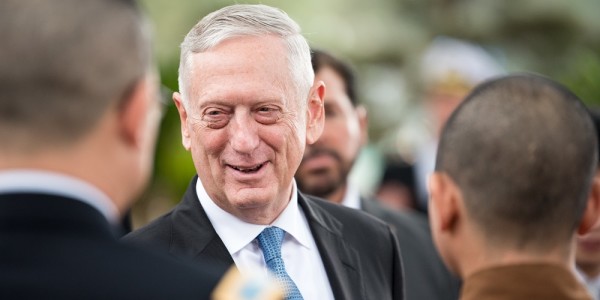

It is not clear exactly how wounded warriors are affected by a new Pentagon policy that aims to push out troops who are deemed “non-deployable” for more than 12 consecutive months.
Defense Secretary James Mattis recently told reporters that the Pentagon will exempt troops wounded in combat from the policy, which was announced on Feb. 14.
“If they were wounded in combat, and they want to stay in and they’ve lost their leg or something like this, and they can’t be a paratrooper anymore, then we’ll find a place to use them,” Mattis told reporters on Feb. 17 during a flight to Washington, D.C. “That’s a special category. They’ve earned that special status.”
Related: The DoD Plans On Forcing Out Injured And Wounded Troops Who Are Unable To Deploy »
Mattis’ comments came just three days after Undersecretary of Defense for Personnel and Readiness Robert Wilkie told Congress that wounded warriors would appear before medical review boards like other non-deployable troops.
“Medical boards review will the medical status of those who have been wounded,” Wilkie told the Senate Armed Services Committee on Feb. 14. “I will use a personal example from 1970: My father was severely wounded in the invasion of Cambodia and spent a year in an Army hospital. A determination was made by a medical board then that his service was still required and he was allowed to recover and return to Fort Bragg in the 82nd Airborne Division.”
However, Wilkie made no mention of a special category for wounded troops, nor did he give any indication that they would automatically be retained.
In follow-up comments to Task & Purpose, he did not say that troops wounded in combat would be exempt from the policy, which requires service members who cannot deploy for more than a year to be processed for administrative for disability separation.
“We respect the contributions of all of our service members, in particular our wounded warriors,” Wilkie told Task & Purpose in a Feb. 16 email. “We owe them a fair process, and this policy allows for that.”
The policy itself does not include any caveats for wounded warriors. It says it applies to troops who cannot deploy “for any reason.”
Related: The Army Plans On Overhauling Basic Training To Focus On More ‘Disciplined, Physically Fit’ Soldiers »
The Pentagon was closed on Monday for a federal holiday. Consequently, a Defense Department spokesman was unable to respond to Task & Purpose’s request for clarity on the policy by deadline.
Mattis told reporters that the non-deployable policy is rooted in fairness: If injured troops cannot go downrange, others have to go in their place. He recalled a conversation he had a couple months ago with a woman, whose husband was on his sixth combat deployment during their 11 years of marriage.
“When that sort of thing happens, that brings sharply into focus that some people are carrying more than the share of the load that I want them to carry,” Mattis said. “They need time at home. They need time with their families.”
Mattis stressed that he is not going to have a military where some troops are constantly deploying while others “seem to not pay that price to be in the U.S. military.” Everyone needs to do their share.
“Sometimes things happen: People bust their legs in training or they’re in a car accident,” Mattis said. “We understand that. Sometimes that even takes a months of recovery. We understand that. But this is a deployable military. If you can’t go overseas in your combat load — carry a combat load — then obviously someone else has got to go. I want this spread fairly and equitably across the force.”
WATCH NEXT:
Want to read more from Task & Purpose? Sign up for our daily newsletter »